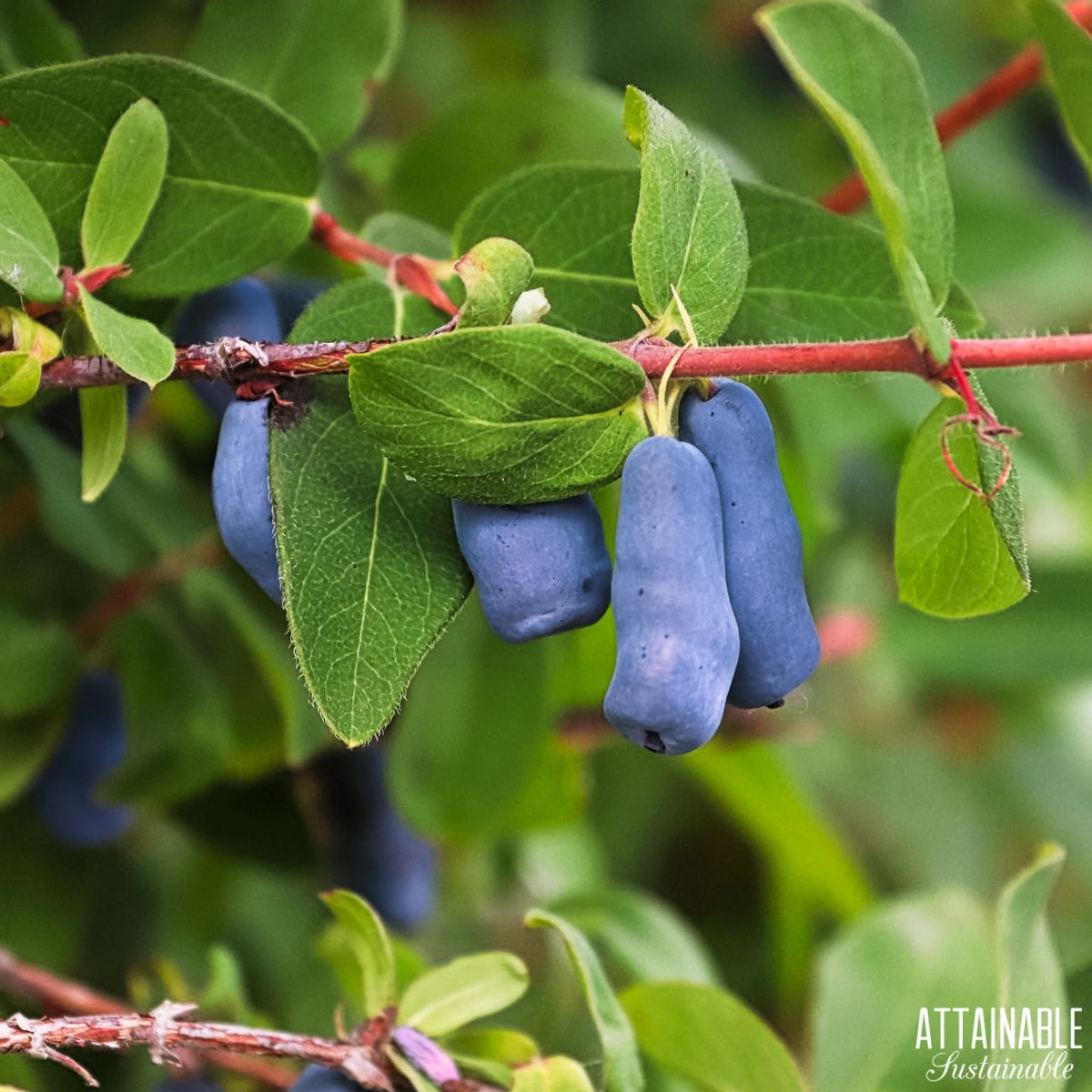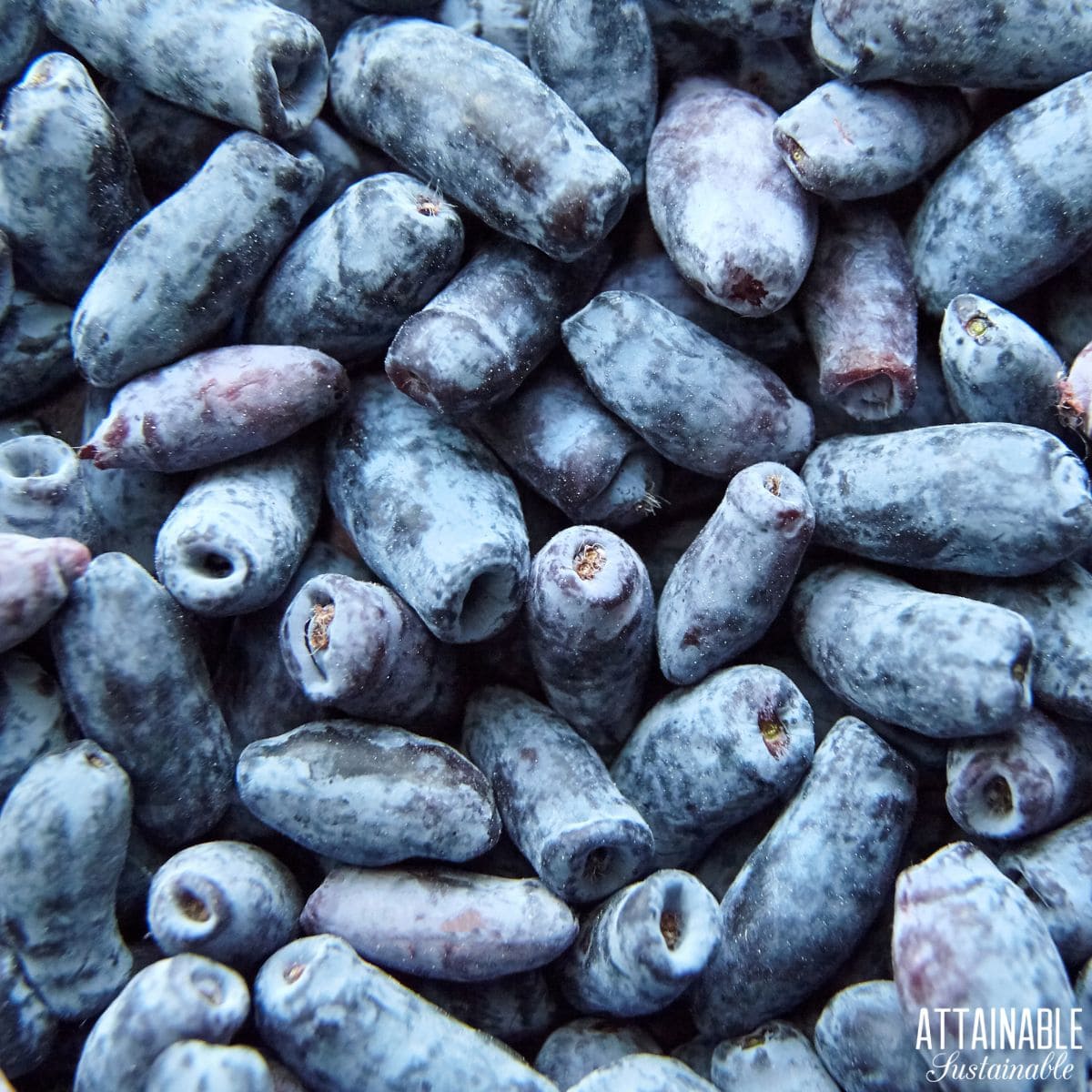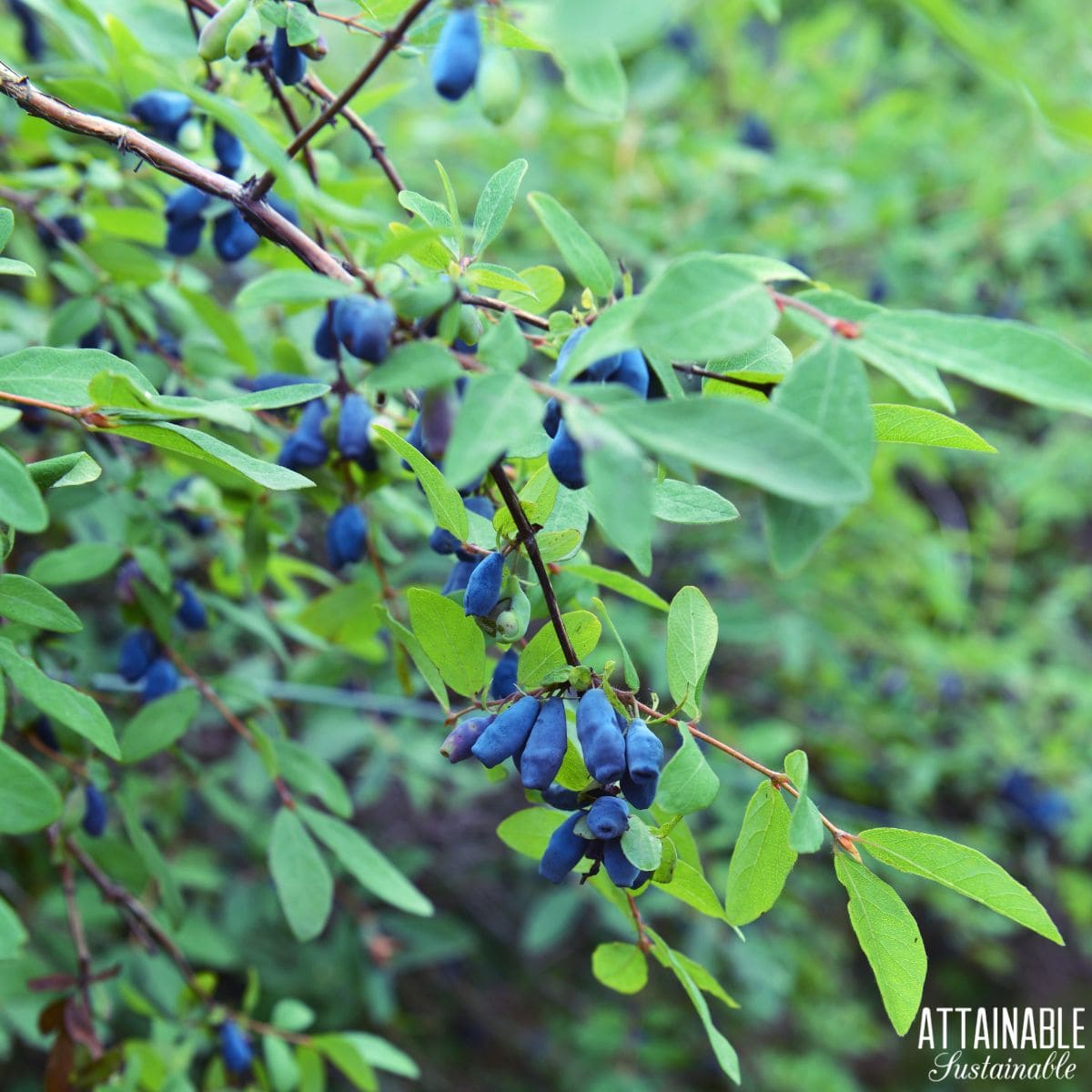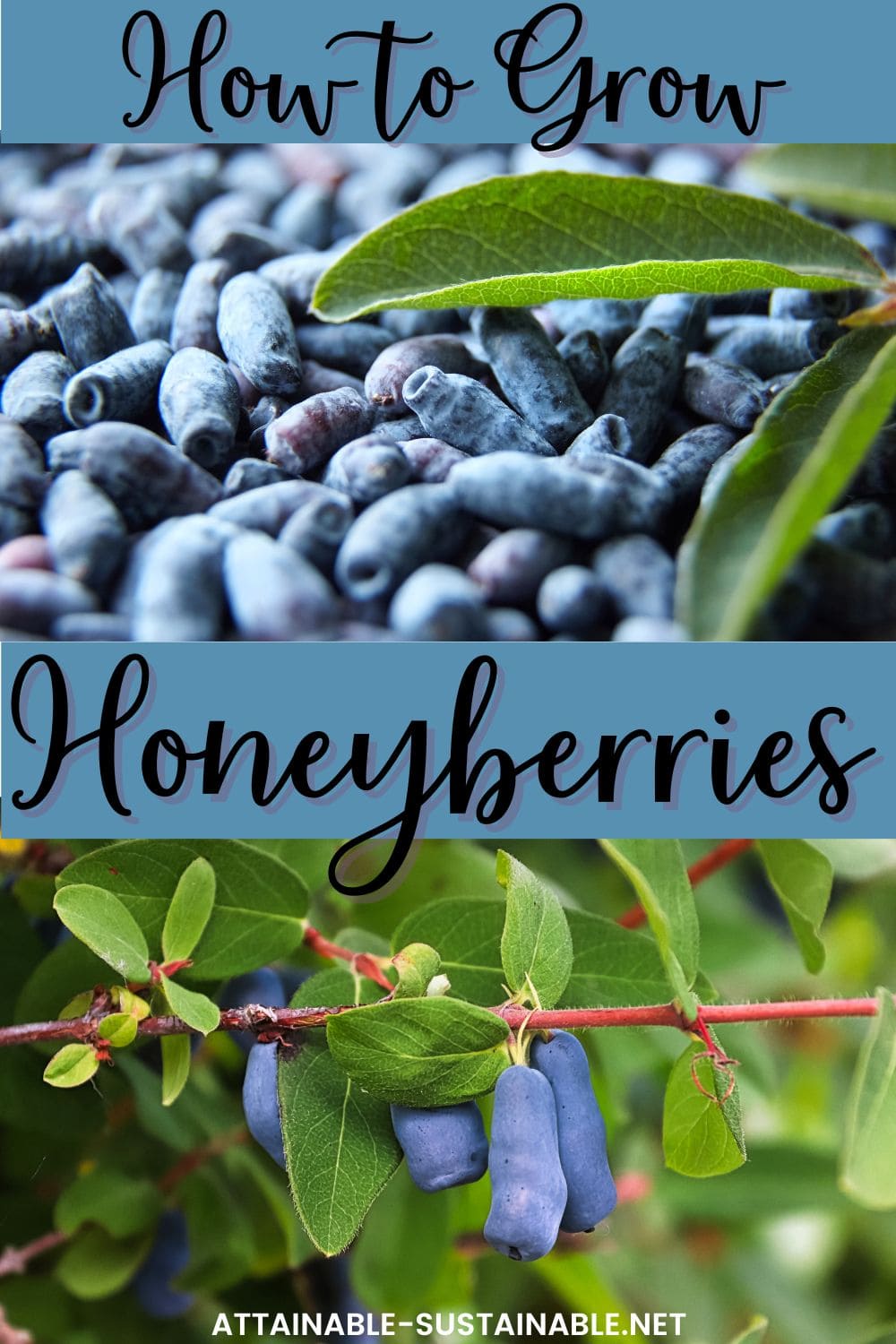Plant honeyberries — also known as haskap berry — if you love blueberries but live in a climate too cold to grow them. With a similar taste, but an oblong shape, honeyberries are a hardy plant that can withstand temperatures in the below zero range. They can be used deliciously in jams, baked goods, and as juice just like any other berry! Perfect for a garden in the cold north so you can rely on sweet berries for eating fresh or canning.
For another easy fruit crop to add to your garden, consider growing grapes!
Contributed by Jodi Torpey, author and Master Gardener.
All About Haskap Berry
Have you always wanted to grow blueberries, but don’t have the right kind of soil or environmental conditions for them to thrive?
If so, there’s an easy-to-grow alternative—haskap berry. Haskap berries look like long blueberries and taste a little like them, too. The haskap plant (Lonicera caerulea) is actually a relative of the familiar ornamental flowering honeysuckle vine but grows edible berries that are enjoyed like blueberries.
Whether you call them haskap shrubs, honeyberries, or blue honeysuckle, this sweet berry is a cold hardy perennial that’s known for being cold-weather tolerant and adaptable to different kinds of growing environments.
Grow Some Greens!
Ready to grow fresh greens, no matter WHERE you live? Sign up for my
FREE quick-start guide and start growing some of your own food!
These tough shrubs can take temperatures that dip into negative numbers during winter and can even take cold temperatures when in full bloom. Most varieties are rated for USDA hardiness zones 3-8.
Haskaps produce small white flowers in early spring that turn into blue fruits for picking in summer. Shrubs grow to 3-6 feet tall and about as wide. When selecting a planting site, be sure to select an area where there’s room for several shrubs to grow for many years and where fruits are accessible to make harvesting easier.
An important point about honeyberries is to be sure to plant two or more varieties with similar bloom times to ensure pollination. Keep in mind it may take several seasons to produce large crops of fruit.
The dark purple berries are packed with vitamins and minerals, making them a nutritionally beneficial choice as well. And they’re delicious for fresh eating!
New to gardening? Limited on space? The 5-Gallon Garden gives you the skills you need to grow food in the space you have. Get started with your garden today!
Varieties for Home Gardens
The two main types of haskaps are Russian and Japanese. Read plant descriptions carefully to make sure you’re selecting the best cultivars for your region.
Russian-type haskaps are cultivars from cold weather areas and have varying degrees of sweetness and fruit size. These cultivars typically bloom earlier in the season than other types. The early bloom time may be an issue in areas where bees aren’t active, so pollination may be hit or miss.
Japanese varieties have a later bloom time than Russian-type cultivars. Japanese-type cultivars may be a better choice for some regions with cold spring weather. These honeyberries have larger and rounder fruits, too.
Here are some popular honeyberry cultivars that grow 3-5 feet tall in hardiness zones 3-8:
Borealis is a mid-season blooming honeyberry that grows especially sweet fruits. Plant this variety for a longer season of berries.
Tundra is an early blooming variety that usually produces some of the first fruits of the season that are firm, but still sweet.
Aurora is another early blooming, productive haskap berry with good flavor and less acidity than some cultivars.
Blue Velvet is a high-yielding honeyberry that grows very large blue berries and is especially tolerant to cold weather.
Honey Bee grows berries that are a little more tart than some honeyberries, but this cultivar is very productive.
Growing Haskap Berries
Select a sunny to partial shade spot. Bushes will benefit from some shade as protection from the hot afternoon sun. Be sure to allow enough space for honeyberry shrubs to grow and spread out.
Honeyberries are a good shrub for early fruit production; in fact, they may be the first to ripen in your garden.
Try to situate berry plants in an area that’s protected from wind, especially in regions that experience severe winter winds. Avoid planting honeyberries in lawn areas as they don’t do well if overwatered or when competing with other plants or weeds for sun and nutrients.
Requirements for Growing
Select a planting site that has well-draining soil or amend the soil with organic matter to aid drainage. Look for a site that can support at least two haskap plants to ensure cross-pollination.
Plant honeyberry bushes slightly deeper than the root ball to help encourage a more robust root system. Space plants 4-6 feet apart in the garden; and rows at least 8 feet apart.
Soil requirements
Unlike blueberries that require acidic soil, honeyberries can grow in a wide range of soils, even those with high alkaline content. Before planting, amend the soil so that it drains well to keep shrub roots healthy.
Light requirements
Honeyberry plants need the sun to grow and produce berries, but they can also suffer from leaf scorch in areas with extremely hot summer sun. Protect shrubs by planting where they’ll get some shade or plan on using shade cloth or other shading methods.
Fertilizer and water requirements
Fertilize shrubs in spring with a well-balanced fertilizer, such as 5-5-5. Honeyberry bushes grow best with consistently moist soil, especially during their first few seasons while getting established in the landscape.
Add drip irrigation or a soaker hose to ensure bushes will get adequate water during the growing season and when winters are dry.
Mulch with an organic mulch, like straw or dried fallen leaves, keeping mulch clear of the stem.
Preventing Problems When Growing Honeyberries
Honeyberry growers say there are few issues with plant diseases and insect pests. However, it’s important to prune shrubs at least once a year, after the harvest. Pruning helps keep plants in shape and improves berry yield.
Be proactive in protecting fruits from birds. You may need to use a support to hold bird netting over shrubs as berries are growing. Use netting with tight crosswires to keep birds from becoming tangled.
Growing in Containers
The shrubs make nice container plants if you take care when planting. Remember to plant at least two containers of honeyberry cultivars that have the same or similar bloom times to ensure pollination and fruit.
Plant haskap shrubs in large enough containers to support the mature size of the cultivars you’ve selected. Shrubs can grow to 4 or more feet tall and nearly as wide. Be sure containers have holes in the bottom to provide for good drainage.
Use good-quality potting soil meant for container growing. Plant the shrub at the same level or a little deeper than in its original container. Water slowly and deeply to keep the soil moist, but don’t let roots sit in standing water.
Monitor the shrub through the season and provide the same care as you would if the shrub was planted in the ground. Protect shrubs from winter winds where possible.
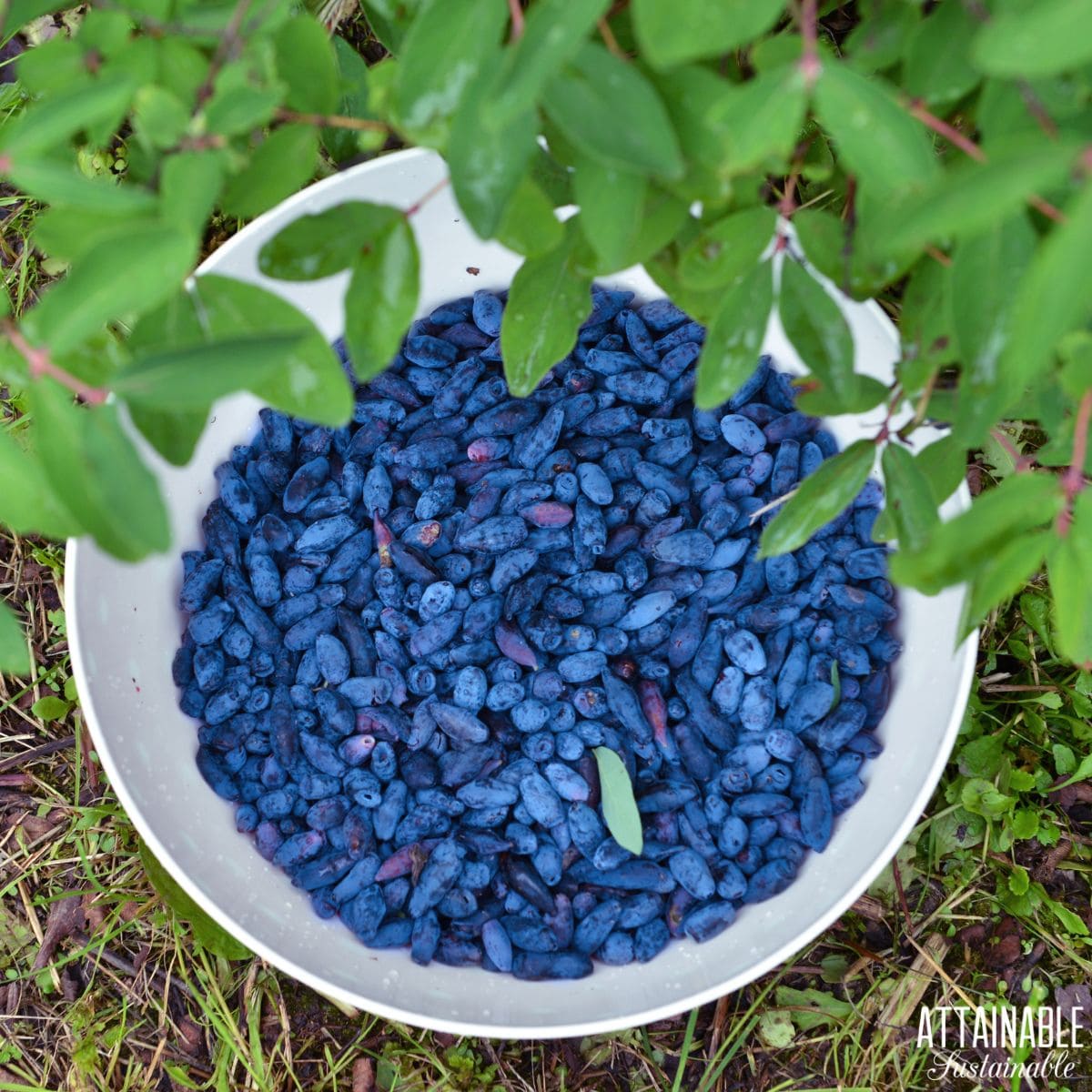
Easily harvest honeyberries by shaking the ripe berries onto a tarp
How to Harvest
Keep track of the number of days to harvest the honeyberry cultivars you planted. Some cultivars may be ripe before strawberries.
Begin harvesting honeyberries when the berries are a consistent dark blue color, but taste a sample to make sure the berries have sweetened. With some cultivars, the fruit turns the right color before they’re fully ripe and sweet.
To make harvesting quicker, place a tarp under the bushes and give the branches a gentle shake to release the berries.
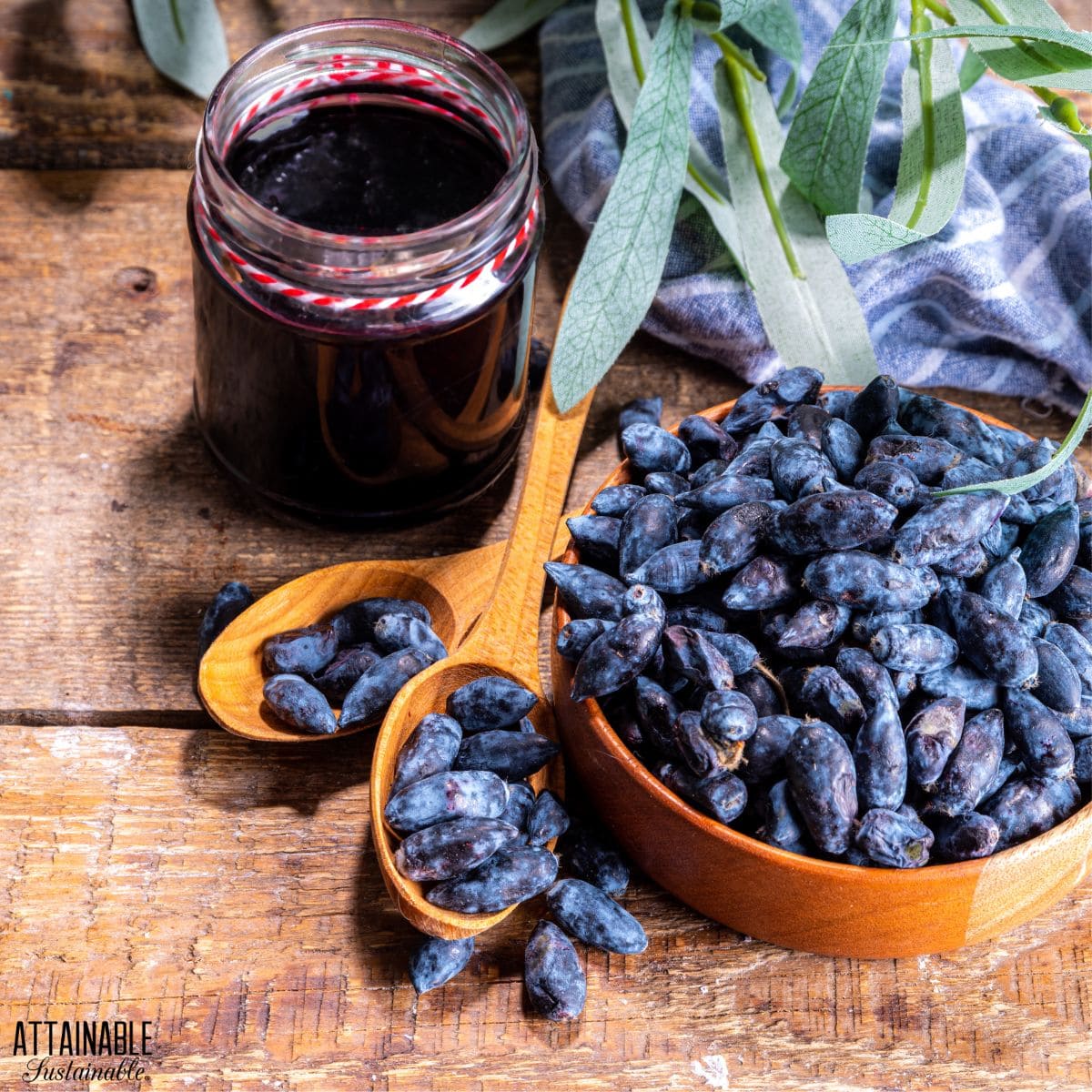
Honeyberry jam can be made just the same as blueberry jam
How to use Haskaps in the Kitchen
Honeyberries have a flavor that some gardeners describe as a mix of blueberries, cherries, and grapes. The fruits are used in cooking like blueberries or other berries that are used for jam, juice, and even wine.
Eat haskaps fresh off the shrub, use them in baked goods and pastries, and add them to yogurt or to top ice cream and other desserts. Honeyberries freeze well to use over the winter, just like frozen blueberries.
Propagating Honeyberries
Haskap shrubs can be propagated from dormant stem cuttings. Wait to take cuttings until late fall or winter. Take a cutting where the past season’s stem joins an older stem.
Dip the cut end in a small amount of rooting hormone and set stems in a sterile growing medium. Water in and check the soil moisture daily to keep stems slightly damp. Roots should form in several weeks, and plants will be ready to transplant to the garden in spring.

